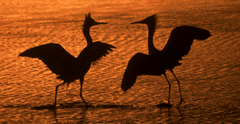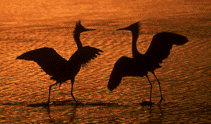I am often asked questions about photographing birds in flight, most recently
by Bulletin subscribers Lance Kreuger and Ray Amos. What follows is everything
that I know about photographing birds in flight that is not covered in "The Art
of Bird Photography" (hereinafter referred to as "the book.")
For handheld flight shooting I use either the Canon EF 100-400mm IS (Image
Stabilizer) L zoom lens, my beloved "Toy Lens:" the Canon EF 400mm f/5.6L, or
infrequently, the Canon EF 300mm f/4.0 L IS lens. Recently, because of the 1-4's
great versatility, I have been using that lens almost exclusively for flight
photography. With all IS lenses, I try to remember to set IS mode 2 (for
panning), though I most often use shutter speeds that are fast enough so that
the IS is not a factor in making sharp images. If I forget, and attempt to pan
with IS mode 1 set, the image in the viewfinder will usually jerk backwards in
the frame as I pan and remind me to switch. I almost always remove the tripod
collar from the intermediate telephoto lenses to reduce the weight and to make
hand-holding more comfortable. (I do not use a shoulder stock.) It is important
to place your left hand well out on the lens barrel so that the lens cam be
easily and properly supported. Many folks place their left hands on the lens
barrel too close to the camera; some even put two hands on the camera! This is
like trying to pick up a log by the end. As for the secrets of panning
successfully, I do not know of any. Simply pick up the lens, point it at a
suitable subject, depress the shutter button half-way to acquire focus, swing
the camera (pan) as the bird approaches you, and make the image by depressing
the shutter-button an instant before the subject is in an ideal position. Oh,
and I forgot to mention: practice. (You can practice with no film in the camera;
gulls make ideal practice subjects.)
For flight shooting with big lenses, I use either the tripod-mounted Canon EF
600mm f/4.0 IS L lens or the Canon EF 500mm f/4.0 IS L lens that I purchased
recently. Anyone who does not use a regular Wimberley head for such flight
shooting is a total dunce (and I said that long before I became a Wimberley
dealer). See the book for details as to why. I place my right hand on the
shutter button and my left hand on the swing knob as this makes panning easier.

(Snow Goose, Bosque Del Apache NWR, NM Canon EF 600 mm f/4
IS L lens, 1.4X TC, EOS 1v body, central sensor. Wimberley head on Gitzo
CF 1548 tripod. Fuji Provia F 100 rated at EI 320 pushed two stops. Sunny 16
exposure for brilliant white set manually: 1/1600 sec at f/5.6.)
Perfect technique plus an understanding of light and wind direction will
help you to create images like this.
Those who have followed my writings will know that I insist on having my
shadow pointing almost directly at the subject for all photography involving
front-lit subjects. Additional factors come into play here. When flight shooting
with the sun directly behind me, and birds flying from left to right, I will
only photograph subjects that are flying into the light. I will
try to acquire focus while the bird is 20 to 40 yards to the left of my position
(and my shadow line). I will pan with the bird and try to make an exposure (or
two at most) as the bird approaches my shadow line. (Unlike many who make ten or
twelve or even 15 images of a bird on a single pass, I never hold the hammer
down when flight shooting, trying instead to anticipate the ideal pose and
subject position). Once the bird passes my shadow line I stop shooting and
so should you. Once the bird passes the shadow line, its tail will be
closer to you than its head. With rare exception, each and every image that is
made after the bird has passed your shadow line and begins flying
away from the light (and from you as well) will wind up in the
trash can. (For birds flying directly towards your position, do try to acquire
focus as early as possible and track the subject on the way in.) Not an IPT goes
by that does not find me yelling out repeatedly in my soft, gentle voice, "Stop
shooting; the bird is past you." When folks, who are delighted to have any bird
in focus in the viewfinder, keep on firing, I try to discourage them by telling
them that I will charge them 37 cents each time that they make an image of a
bird that is past the light. This represents the approximate cost of making a
single image on color slide film. When the wind is opposite the sun and the
birds are flying directly away from you or landing with their backs to you,
"over-the-shoulder" portraits can work. I love shooting Sow Geese flying away at
slow shutter speeds with the 2X TC on a big IS lens
I do not hesitate to use my 1.4X teleconverter with either of my
super-telephoto lenses when flight shooting. Results are similar to those
achieved with the prime lens alone although Initial Focus Acquisition takes
slightly longer. At times, I will attempt to do some flight shooting with the 2X
TCs. Results here are spotty; I have made some incredibly sharp images flight
shooting with the 2X, and many marginally sharp and just-plain-soft ones as
well.

(Immature Bald Eagle, Bosque Del Apache NWR, NM. Canon EF
600mm f/4 IS L lens, 2x TC, Canon EOS 1v, central sensor. Wimberley head
on Gitzo CF 1548 tripod. Fuji Provia F 100 rated at pushed two stops.
Evaluative metering + 1/3 stop: 1/1000 at f/5.6.) With practice, it is
possible to maintain focus on birds flying below the horizon, even with the 2X
TC.
My main flight shooting film is Fuji Provia F 100 pushed one or two stops
(rated at EI 200 and 320 respectively). When shooting the 500 or 600 mm lens
without a TC, I will use Fuji Velvia pushed one stop. Though I often have lots
of extra shutter speed available when using fast film, I utilize the wide open
aperture 99% of the time. The faster the shutter speed, the sharper the in-focus
images will be. On my recent Bosque trip I frequently found myself using shutter
speeds as high as 1/4000th of a second.
For photographing single birds in flight, I almost always use the central
sensor only (the exception being in extreme low light when I will resort to
using AFPS).

(Snow Geese, Bosque Del Apache NWR, NM Canon EF mm f/4 IS
L lens, EOS 1v body, AFPS (45 sensors active). Wimberley head on
Gitzo CF 1548 tripod. Fuji Provia F 100 pushed one stop. Evaluative
metering +2/3 stop: 1/125 sec. at f/4.)
Here,
with two birds in the frame, the EOS 1v's AFPS system worked to perfection in a
situation where central sensor only might have failed to hold focus.
For small in the frame subjects, I will choose a side sensor so that the bird
will be placed pleasingly off-center. With Canon’s 45 point AF pattern, I advise
that you never use the AFPS mode for single birds in flight (except as noted
previously) as I have found that it does not focus very accurately at all.
(Note, however, that some other very competent photographers, Cliff Beittel for
one, prefer to use AFPS for some flight shooting situations. With cameras that
feature the 45-point AF system, I do not set the custom function
that allows surrounding sensors to help in attaining and maintaining focus. Why
not? I want the fine AF control that is attainable when using the central sensor
only. For subjects that fill roughly half-frame, I simply strive to place the
central sensor on the bird’s eye, face, or neck; this will yield a pleasing
composition and will leave lots of "flying room" in front of the bird.

(Sandhill Crane, Bosque Del Apache NWR, NM Canon EF 600 mm
f/4 IS L lens, EOS A2 body, central sensor. Wimberley head on Gitzo
CF 1548 tripod. Fuji Velvia pushed one stop. Sunny 16 exposure for a
middle tone: 1/1600 sec. at f/4.) In this image, placing the central
sensor on the bird's neck yielded a perfect composition.
Many folks (and that includes both Canon and Nikon shooters) often ask why
their AF system fails when the bird drops below the horizon and the background
switches from sky to mountains, fields, or distant woods. The fact is that the
fault lies not with the AF system, but with the photographer. If you keep the
central sensor on the subject and do not let it slip off, accurate focus will be
maintained. If you allow the sensor to slip off of the subject, even for an
instant, the system will focus on the background. (With the sky as background,
the AF system simply does not see the sky.) Keeping the sensor on
the subject while panning requires lots of practice and more than a bit of fine
motor control as well. (One IPT participant asked me in a serious manner if
Canon sold that, "that" being fine motor control. "Unfortunately," I responded,
"they do not."
For photographing groups or large flocks of birds in flight, I
do recommend using one of the array AF patterns if your camera
offers an array pattern. This would be the five-across sensor pattern in the
Canon A2 or 1n, the 45 point AFPS mode with the Canon EOS 3 or 1v, the
seven-sensor AF layout in the new Elan 7s, and the dynamic AF mode with the
Nikon F-5 or F-100. (Note; several Nikon-using IPT participants have stated that
they feel that AF tracking accuracy with F-100 is better than with the F-5 where
many have indicated that there is a problem with the AF picking up middle-toned
subjects against middle-toned backgrounds.)

(Sandhill Cranes, Ed Krane Pond, Bosque Del Apache NWR, NM Canon
EF mm f/4 IS L lens, EOS 1v body, AFPS (45 sensors
active). Wimberley head on Gitzo CF 1548 tripod. Fuji Provia F 100
rated at EI 320 and pushed two stops. Evaluative metering +1
stop: 1/180 sec. at f/4. A new pond right on Highway 1
provided great opportunities to create silhouettes of parachuting cranes coming
into their evening roost. Again, the 1v's AFPS system help focus
perfectly.
Even with the amazing predictive AF systems offered in many of today’s top
cameras, flight shooting is--like skeet shooting--a difficult task. I would say
that under good conditions more than half of the flight shots that I make are
either acceptably, very, or exceptionally sharp with the latter probably
accounting for about 10% of the flight image that I create. (When flight
shooting conditions are perfect with birds flying into the light and hovering
into the wind, it is often possible to have nearly all of the images on a roll
turn out either very or exceptionably sharp.) Under most conditions, however,
AF--as wonderful as it is, ain’t perfect. Note however, that before AF, I made
only 3 sharp flight images in about a decade.........


